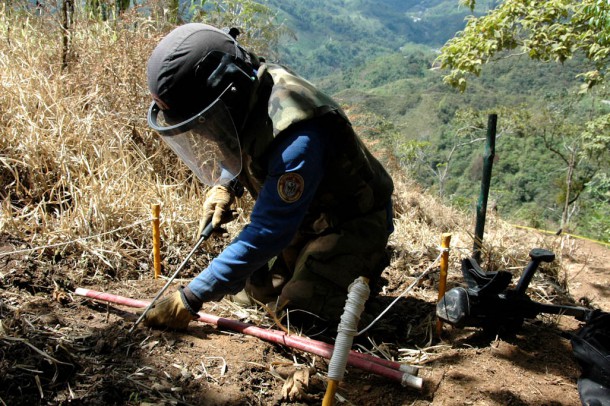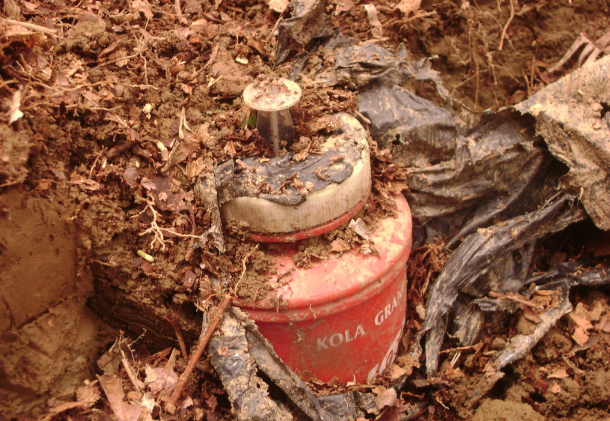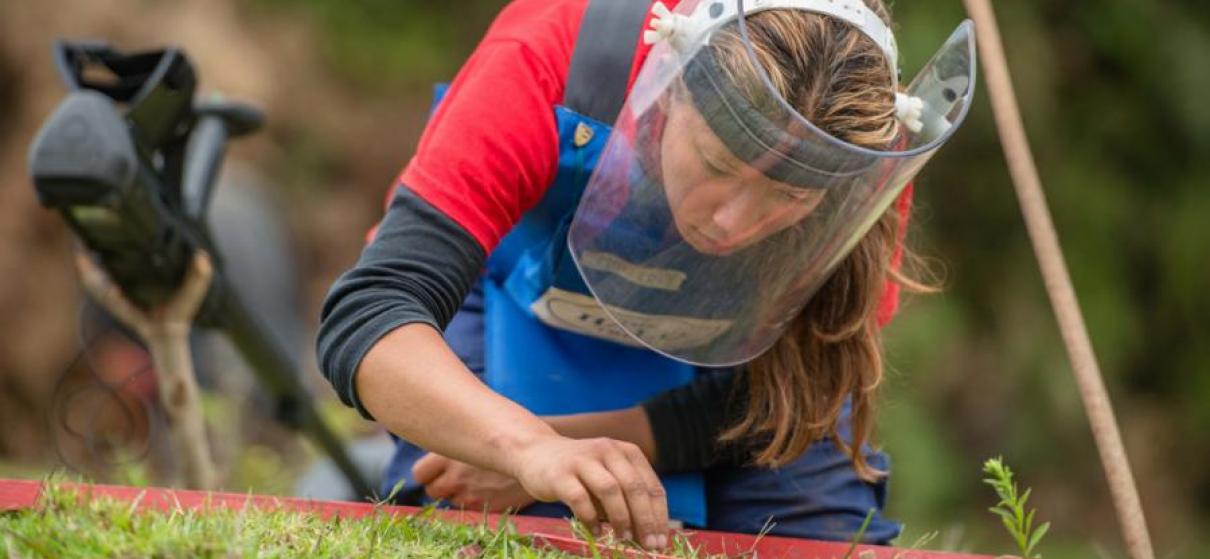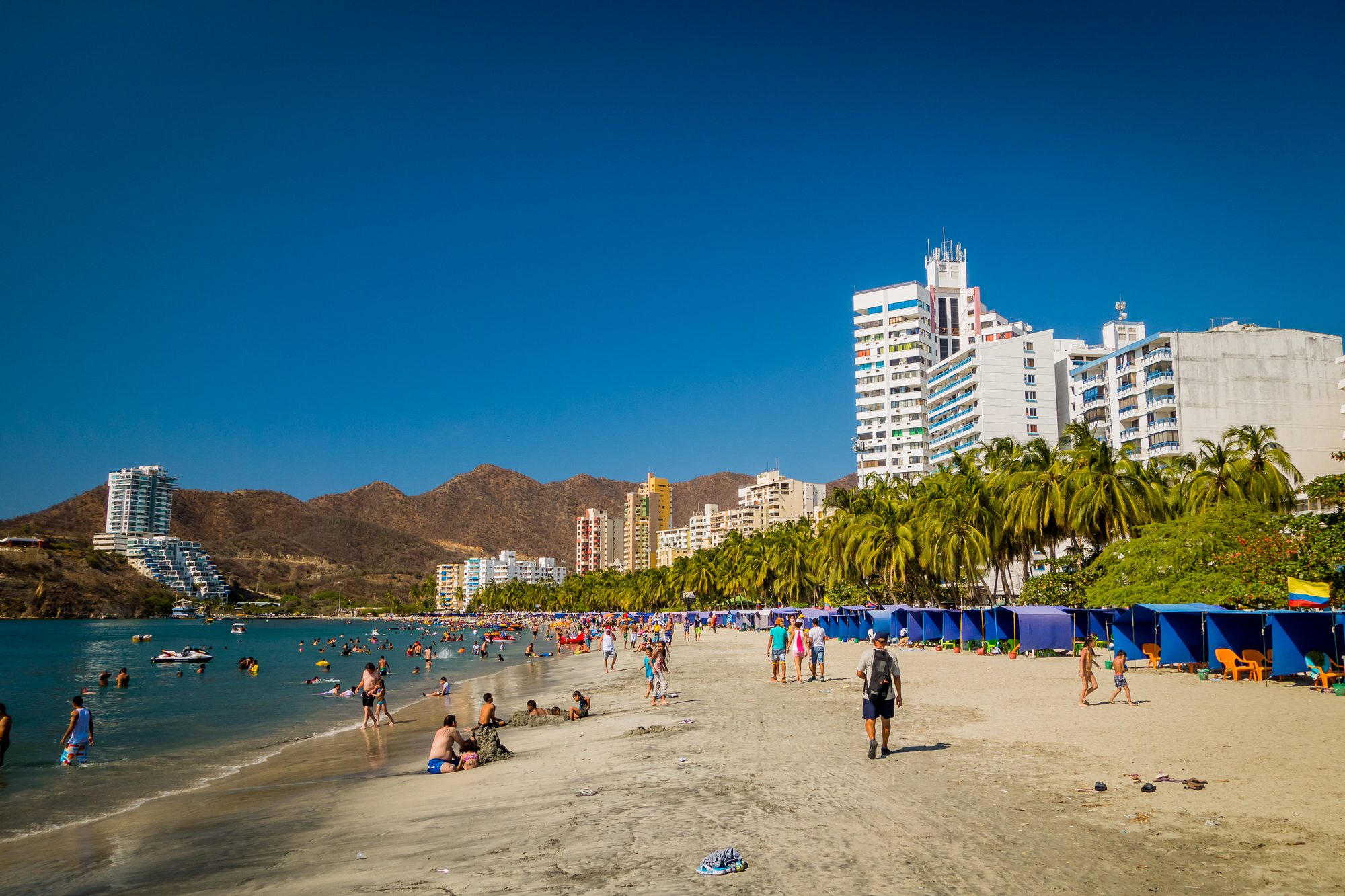Emily Dawson and Charlotte Ryan examine Colombia’s landmine problem and the ambitious plan to clear the countryside
Colombia’s ongoing civil war and the associated violence has been well-documented, but there’s one facet of the conflict that is often overlooked: landmines. Colombia has the second-highest number of landmine victims in the world. According to NGO Campaña Colombiana Contra Minas, up to 11,800 people – including 1,101 children – have been killed or wounded by explosive devices since 1990.
What makes landmines in Colombia so lethal is their location: 31 of the 32 Colombian departments are mined, and 97 percent of blasts have occurred in rural areas, meaning they injure and kill high numbers of civilians and soldiers in these zones.
There had already been 45 landmine victims by March 8 this year – that’s one person every day and a half. While the number of explosions has reduced in recent years, they still pose a real threat to the communities where mines have been planted.

Careful hands use a metal stick to poke around for the sign of a buried explosive: the top of a syringe, an activation cable or detonation pin. Photo: globalpost.com
According to the International Campaign to Ban Landmines (ICTBL), every day, 10 people in the world are injured or killed by landmines. The mines are buried in the ground and can lie dormant for years before being triggered by the presence of an adult, child or animal. The ICTBL puts it bluntly: “They blow off their victims’ legs, feet, toes and hands. They fire shrapnel into their faces and bodies. They kill.”
The challenge is that once the mines are in the ground, they don’t go away until they either explode or are cleared. And that means that the people who live in those areas can’t use their land without fear of explosions, which is why the announcement from the government and FARC rebels that they have agreed to remove landmines found throughout the country is so historic, and has been greeted with such enthusiasm by all sectors of society.
On March 7, government peace negotiators and the FARC delegation in Havana announced their intention to clear the battlefields throughout Colombia of landmines, explosive devices and unexploded ordinance, in an operation to be overseen by experts from Norwegian group People’s Aid. The process is due to start sometime in the next six weeks.
“The demining proposals are a first step, but a giant step towards making peace,” chief government peace talks negotiator Humberto de La Calle said of the mine-clearing agreement.
Lead FARC negotiator Ivan Marquez said the deal to remove the explosives “has fulfilled the dreams of thousands of people living in our country.”
Observers see this agreement as a huge step forward in the two-year old peace process taking place in Havana, Cuba, as it sets out a concrete way for the government and the FARC to co-operate. The Bogota Post spoke to a member of an anti-landmine NGO who used to work with the victims, and he saw the announcement as a very positive gesture.
“I believe that this is a huge sign that they [the FARC and the government] are getting closer to a final agreement, because they have both dropped their most important and strategic weapons. The FARC agreed on the demining and the government stopped the aerial bombings,” the NGO worker, who wished to remain anonymous, said.
Latest: FARC Peace talks conclude with comprehensive agreement
As with many issues connected to the peace talks, however, the road is not straightforward. On Monday, March 23, FARC spokesman Rodrigo Granda said from Havana that the guerrilla group had only committed to helping the government with “humanitarian demining,” in four heavily populated areas of the country. The group will continue to use landmines against the military, and Granda added that the peace process is “not yet irreversible.”
Historically, both state and rebel actors have used strategic landmines in the Colombian conflict. However, in 1997, the government promised to stop the production and use of landmines, and to destroy all mines in their possession when Colombia became a signatory of the Ottawa Treaty. They now say “the only landmines remaining in Colombian military possession are those remaining in the ground as defensive measures around a few military installations.”
Under the new agreement, a Colombian army battalion which specialises in removing mines will clear explosives at a selected number of sites, working under the supervision of a team to include two government officials, two FARC members and two residents from affected communities.
President Juan Manuel Santos praised the demining deal: “I want to congratulate our negotiators and I appreciate this step taken by the FARC.”
But it might be too early to celebrate – the landmine removal is likely to be an extremely long, expensive and complex process.
A ‘Mine-Free’ Colombia
The government has set 2021 as the goal for the country to be ‘mine-free’, but precedents from other countries suggest this process could take as long as 50 years. Nicaragua, a country approximately one-tenth the size of Colombia, worked for 20 years to declare itself ‘mine-free’, after an operation which began in 1989 and was funded by the Organisation of American States.
There are some parallels between the situations in the two countries. Like in Nicaragua, mines in Colombia were laid by both actors in the conflict – the leftist guerrillas and the military – but in both countries it is the mines laid by guerrillas that prove to be more difficult to unearth. Nicaraguan President Daniel Ortega said that it was thanks to the military’s cooperation with local communities that the country was able to rid itself of mines successfully; in Colombia a similar strategy is planned.
As Sofia Miranda, Area Coordinator for Campaña Contra las Minas, told The Bogota Post, “I think it is really difficult to talk about timeframes [for demining], because first we have to define which are the priority zones. The organisation chosen to do this process is the Norwegian People’s Aid, but the NPA itself is currently in the process of accreditation to be able to carry out demining activity.”
The process is complicated further by the fact that almost all of the mines in Colombia are “non-industrial” homemade mines manufactured in guerrilla camps at low cost. This can make them harder to detect, as many don’t contain metal and so won’t set off traditional detectors. It costs approximately $2 USD to plant an explosive, and around $1,000 USD to remove the device.
Although they have agreed to co-operate with the government, the FARC do not know the location of all of their mines; the military drew maps showing where they had placed theirs, while the FARC has almost no record and planted them at random. Many of the mines were laid by FARC members who have since been killed, and heavy rains can also cause mines to shift over time.
Furthermore, without the collaboration of Colombia’s second largest guerrilla group, the ELN, it will be more difficult: An estimated 25 percent of landmines were laid by this group, according to government statistics, and 1 percent by the now-disbanded paramilitary group, the AUC.

Many of the mines in Colombia are improvised. They are normally made out of common household items, such as coffee cans, soda bottles, and jerry cans. Photo: HaloTrust.org
As for the cost of demining, General Rafael Colon, director of the government’s Anti-Landmine Programme, estimates that the initiative will need USD$100 million. Colon told local media that this money would come out of the government budget, but added, “of course, as it is so expensive, we will need international support.”
On the other hand, the gains of clearing landmines could be huge. As a 2009 report said, “the social and economic losses due to the extended use of [explosives] by illegal groups in Colombia are so large they are nearly incomprehensible.” Mines have caused huge numbers of people to be displaced from their land, as well as the loss of natural resources due to land being unsafe to farm.
UK charity the Halo Trust has 200 deminers working in Colombia. In one case study, the charity described clearing land for Colombian farmers who had been displaced as part of the conflict. The clearing of their land enabled the farmers to cultivate more crops and increase their income. The effects of this on a countrywide scale could be massive, both socially and economically, and enable some of Colombia’s 3.6 million internally displaced people to return to their homes.
It is clear that there is a lot of expensive and painstaking work to be done – both at the negotiating table and, more importantly, in the field. But for the communities who live with the daily peril of landmines, every step forward is a step out of danger.How does the Colombian military clear landmines?
How does the Colombian military clear landmines?The military uses a five-step strategy, as told to BBC Mundo: 1. Scan the area with binoculars looking for trip wires. 2. A soldier throws a heavy, explosive-resistant weight attached to a long rope into the field and drags it back, as it detonates any mine it comes across. 3. A sniffer dog and trainer go into the field, in order to identify non-metal explosives. The dog is not at risk as trip wires have already been spotted. 4. Two soldiers scan the area with a metal detector 5. The sergeant detonates any devices which have been found. However, studies show that manual demining continues to be the most effective, and for humanitarian demining the UN demands a 98 percent success rate. This is usually only achieved by a combination of technology and human labour, as seen here. |
Are there other methods?Many different methods for detonating land-mines have been researched. Including: • Giant rats – In Mozambique, African giant pouch rats were used to try and meet the country’s “mine-free” target faster. The rats are the same size as a small cat and so can detect mines without causing them to explode. They then scratch the ground to alert their handler, who follows with a metal detector. According to their handlers, the rats work much quicker than humans: able to check 200 square metres of land in thirty minutes, compared to three days for a human. • Honey bees – In research by the University of Montana, the insects were shown to have a higher rate of accuracy than dogs or rats in detecting landmines, but they are yet to be used outside of lab trials. • Elephants – The mammals can smell landmines with 97 percent accuracy, according to a team of researchers, who have no plans to send elephants into the field but are instead attempting to apply the elephants’ technique to electronic sensors. • Dogs – Our furry friends remain the most popular detector, used in countries including Colombia and Afghanistan. • Humans – With all of these methods, humans are still an essential part of the process. Clearing landmines can be dangerous work, but in other post-conflict zones such as Cambodia it has been used as a way to provide employment to demobilised guerrillas or to women who live near conflict zones, allowing them to work and also remain close to their families. It’s not a job to enter lightly: the UN says that one mine clearance specialist is killed, and two injured, for every 5,000 mines cleared. |
By Charlotte Ryan & Emily Dawson







